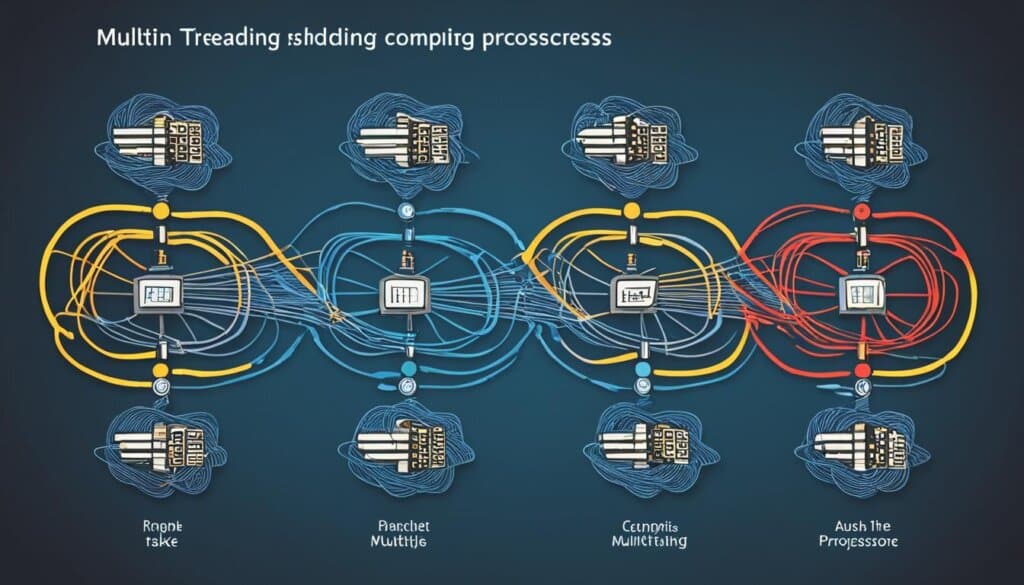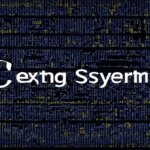Table of Contents
When it comes to computing, multithreading plays a crucial role in enhancing efficiency and performance in various applications. But what exactly is multithreading and how does it work? In this article, we will delve into the world of multithreading, exploring its benefits, applications, and how it differs from multitasking and multiprocessing.
Multithreading refers to the ability of a program or operating system to handle multiple user requests or tasks simultaneously without requiring multiple copies of the program running on the computer. It achieves this by breaking programs into smaller executable threads, allowing them to be executed on a single processor. Although each thread is executed individually, the CPU processes them so quickly that it appears as though they are executed simultaneously.
One key requirement for multithreading is fast CPU speed, as it enables rapid execution of the different threads. Additionally, large memory capacities are necessary to accommodate the demands of multiple threads. Multithreading can also be combined with parallel processing and multicore processors, further boosting performance and efficiency.
Multithreading offers a myriad of advantages in computing. By breaking programs into smaller threads and executing them in parallel, it significantly improves efficiency and performance. The utilization of multiple CPU cores reduces execution time and enhances speed. Moreover, multithreading allows for the execution of multiple tasks simultaneously, maximizing resources and improving overall system performance.
In the upcoming sections, we will delve deeper into how multithreading works, its distinctions from multitasking and multiprocessing, and explore its applications in various fields. Stay tuned to discover the power and potential of multithreading!
How Multithreading Works
Multithreading works by utilizing the fast processing speeds of modern microprocessors. While the processor can only execute one instruction at a time, multiple threads from different programs are executed so quickly that it appears as though the programs are executing simultaneously.
Each thread is linked to all other threads in its stream, and synchronization occurs rapidly to create the illusion of concurrent execution. Multithreading allows for the simultaneous execution of multiple threads, maximizing the utilization of CPU resources and enhancing overall performance.
However, the efficient execution of multithreading requires careful attention from programmers. They need to avoid common pitfalls such as race conditions and deadlocks.
Race Conditions
A race condition occurs when multiple threads try to access and modify shared data simultaneously. This can lead to unexpected and undesirable outcomes as the threads may interfere or conflict with each other’s operations. To prevent race conditions, programmers use synchronization techniques such as locks, semaphores, or monitors to control thread access to shared resources.
Deadlock
Deadlock is a situation where two or more threads are unable to proceed because each is waiting for the other to release a resource. This can happen when threads acquire resources in different orders, resulting in a circular dependency. Programmers must carefully design thread synchronization mechanisms to avoid deadlocks and ensure the smooth execution of multithreaded programs.
In summary, multithreading harnesses the power of CPU speed to execute multiple threads simultaneously. It requires effective thread synchronization to prevent race conditions and deadlocks, ensuring smooth and efficient execution of multithreaded programs.
“Multithreading allows for the simultaneous execution of multiple threads, maximizing the utilization of CPU resources and enhancing overall performance.”
| Multithreading Advantages |
|---|
| Efficient utilization of CPU resources |
| Improved overall performance |
| Simultaneous execution of multiple threads |
| Reduced execution time |
Multithreading vs. Multitasking vs. Multiprocessing
A clear understanding of the differences between multithreading, multitasking, and multiprocessing is crucial in the world of computing. Although these concepts are related, they serve distinct purposes and have unique characteristics.
- Multithreading is the process of breaking programs into smaller executable threads, allowing for concurrent execution. It enables multitasking by dividing programs into smaller units of work, known as threads, which can be executed independently. Each thread contains the necessary elements to execute the main program, and the computer executes each thread one at a time. Multithreading is ideal for improving the efficiency and performance of concurrent programs by allowing simultaneous execution.
- Multitasking refers to a computer’s ability to execute two or more programs concurrently. It involves switching between different programs, providing the illusion of parallel execution. Multitasking is made possible by the use of multithreading, as it allows for the execution of multiple threads from different programs. This allows users to perform several tasks simultaneously, enhancing productivity and user experience.
- Multiprocessing revolves around utilizing multiple CPUs to enhance overall processing capabilities and support multitasking. In multiprocessing, each CPU can execute its own set of instructions concurrently. This allows for a significant boost in performance, as multiple tasks can be completed simultaneously. Multiprocessing is particularly effective for computationally intensive tasks that require high computational power.
“Multithreading enables multitasking, while multiprocessing utilizes multiple CPUs to support parallel execution.”
It’s important to note that multithreading can be combined with parallel processing and multicore processors to further enhance performance. Parallel processing involves utilizing multiple CPUs to handle separate parts of a task simultaneously, while multicore processors have multiple processing units on a single CPU. These technologies offer increased processing power and improved efficiency, making them valuable additions to the computing landscape.
Comparison Table: Multithreading vs. Multitasking vs. Multiprocessing
| Multithreading | Multitasking | Multiprocessing |
|---|---|---|
| Breaks programs into smaller executable threads | Enables execution of two or more concurrent programs | Utilizes multiple CPUs for enhanced processing |
| Allows for concurrent execution of threads | Provides the illusion of parallel execution | Enables simultaneous execution of multiple tasks |
| Ideal for improving efficiency and performance | Enhances multitasking capabilities | Boosts overall processing power |
| Can be combined with parallel processing and multicore processors | – | – |

Advantages of Multithreading
Multithreading in computing offers numerous benefits that enhance efficiency, performance, and overall system productivity. By breaking programs into smaller threads and executing them simultaneously, multithreading significantly improves efficiency and reduces execution time. This parallel execution allows for the utilization of multiple CPU cores, maximizing resources and increasing speed.
One of the key advantages of multithreading is its ability to leverage the full potential of modern multicore processors. Multithreaded applications can execute multiple tasks concurrently, unlocking the power of parallel processing. This parallel execution not only boosts performance but also improves multitasking capabilities, as different threads can be executed simultaneously, handling different functions.
In time-consuming tasks or applications that require executing multiple independent functions concurrently, multithreading proves particularly beneficial. By dividing the workload into smaller threads and executing them in parallel, multithreading reduces execution time, ensuring faster completion of the task at hand. This results in improved productivity and enables systems to handle complex and resource-intensive applications more efficiently.
FAQ
What is multithreading?
Multithreading is the ability of a program or operating system to handle multiple user requests or tasks simultaneously without requiring multiple copies of the program running on the computer. It allows for greater efficiency and improved performance in various applications.
How does multithreading work?
Multithreading works by utilizing the fast processing speeds of modern microprocessors. While the processor can only execute one instruction at a time, multiple threads from different programs are executed so quickly that it appears as though the programs are executing simultaneously. Each thread is linked to all other threads in its stream, and synchronization occurs rapidly to create the illusion of concurrent execution.
How does multithreading differ from multitasking and multiprocessing?
Multithreading differs from multitasking and multiprocessing, although they are related concepts. Multitasking refers to a computer’s ability to execute two or more concurrent programs, and multithreading makes multitasking possible by breaking programs into smaller executable threads. Multiprocessing, on the other hand, utilizes multiple CPUs to speed up overall processing and support multitasking.
What are the advantages of multithreading?
Multithreading offers several advantages in computing. By breaking programs into smaller threads and executing them in parallel, multithreading can significantly improve efficiency and performance. It allows for the utilization of multiple CPU cores, reducing execution time and increasing speed. Multithreading is especially beneficial in time-consuming tasks or applications where multiple independent functions need to be executed concurrently.












